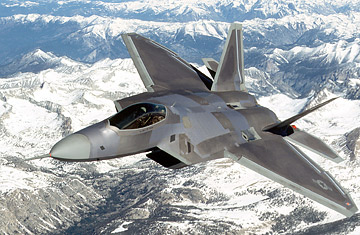
Like a kid telling Santa — okay, his parents — that his X-Box is obsolete and that he needs to replace it with a Wii, the Air Force is engaging in its own bit of "woe is me" this holiday season. But jet fighters capable of "super-cruise" and eluding enemy radars are a tad more costly than junior's games. The Air Force does have a legitimate problem with its F-15 air superiority fighters, which began flying, on average, 25 years ago. With the U.S. military facing no head-to-head challenge in the skies, the F-15's prime role since 9/11 has been to respond to any hijacking of a commercial airliner and, if necessary, to shoot it down before it can become a missile aimed at a population center. But the newer and cheaper F-16s are perfectly adequate for that mission.
Last month, an F-15 disintegrated in mid-air over Missouri (the pilot parachuted to safety), and subsequent checks of the fleet's structural integrity revealed that eight of the planes have cracks in a pair of key beams just behind the cockpit. (The problem is limited to the 442 F-15A to F15D air-to-air models; the 224 stronger-framed F-15E fleet, which also can drop bombs, is a decade newer than the air superiority version and isn't affected).
Air Force officials say the strains of high-speed maneuvers have weakened the F-15s. In fact, the November 2 disintegration happened while the plane was in the middle of a 500-mph mock dogfight that put it under forces eight times that of gravity. The Pentagon is often criticized for fighting the last war, but in this case, the Air Force is fighting World War II. Winning an aerial dogfight ranks right up there with mounting a cavalry charge as required skill for today's military. Billions of dollars have been spent over the past generation buying long-range missiles such as the Phoenix and AMRAAM expressly designed to allow U.S. fighters to blast enemy airplanes from the skies long before the bad guys even see the American plane. If the U.S. military would acknowledge this, and curb its dogfighting drills, F-15s and other warplanes wouldn't wear out so fast.
But there is an upside to the wear and tear: The Air Force has been telling anyone who will listen that it needs more of its prized F-22 Raptors than the 183 that have been authorized by its Pentagon masters and funded by the Congress at $350 million a piece. In fact, they want to more than double the Raptor fleet and buy another 200 more. Why patch up aging F-15s for a pittance when there is a Lockheed Martin assembly line in Texas wrapping up work on those 183 F-22s that could be kept in business popping out more to solve the F-15 shortage?
But the F-22 suffers from the same overbuilding as the F-15. Sold as a way to guarantee "air dominance" for the U.S. Air Force against a Soviet air force that no longer exists, the F-22 morphed into the F/A-22 in 2002. That "A" — for "attack" — meant that the F-22 wasn't only a fighter, but could attack ground targets as well. After three years, though, it lost the "A" and was renamed simply the F-22 once again by a new crop of Air Force officials smarting that the Navy had used the "F/A" label to make its F-18 seem more relevant several years earlier. The Air Force's next challenge will be to convince those who hold the purse strings to build more of a plane designed for an enemy, and a kind of war, that no longer exists.
